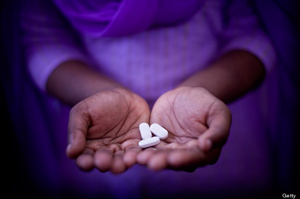
Source: www.guardian.co.uk
Myth No. 1: I can get HIV just by being around people who are HIV-positive
You cannot get HIV by eating from the same utensils, swimming in same swimming pool, kissing, hugging, playing in the same playground, attending funerals (of people with HIV) etc. HIV is only transmitted through contact with infected person’s body fluids like blood, breast milk, semen and vaginal secretions.
Some people worry about the possibility of getting HIV from spilled body fluids like dried blood. Although HIV may live for some time outside the body, HIV transmission has not been reported as a consequence of contact with spillages of blood, semen or other body fluids.
Myth No. 2: I can tell if a person has HIV infection by just looking at them
People infected with HIV look, talk and walk like a normal uninfected person. Young, old, religious or not, regardless of the sexual orientation – all of us are vulnerable towards HIV infection. Some of them are not even aware of their HIV status. It is currently estimated globally that about half of the people living with HIV do not know their HIV status.
This is why we advise to practice safe sexual practice regardless with whom you have it with. For health care workers, we advise to take safety precautions like double gloves when handling body fluids, sharp objects or biohazard material in all patients regardless of the infection status.
Current WHO guideline recommends that EVERYONE should be tested especially if you live in places with high HIV prevalence. This is because no one is immune to HIV.

Source: scienceillustrated.com.au
Myth No. 3: I can get HIV from mosquitoes.
No you could not. This is because HIV cannot multiply in mosquitoes, bed bugs, fleas, or other blood sucking insects. HIV also cannot survive long in mosquitoes so the possibility is low for HIV to get transmitted through them.
Myth No. 4: I am HIV positive so I cannot breastfeed/HIV can be transmitted through breast milk so I cannot allow my baby receive this donated breast milk
HIV can be transmitted through breast milk but if a woman living with HIV decides to breastfeed, it is then safe to do so as long as she and the child are on antiretroviral treatment. This is because risk of transmission is linked to how much virus she has in her and taking antiretroviral therapy would help to reduce the amount of virus .
Infants of HIV positive mother have the option of having donated breast milk. Donated breast milk is safe provided that breast milk donors are screened for infectious disease or you can do ‘flash heating’ to pasteurize donated breast milk.
You can get more information on flash heating here – http://www.hciproject.org/sites/default/files/How%20you%20can%20safely%20heat%20treat%20breast%20milk_English_0.pdf
Myth No. 5: I have just been diagnosed as HIV-positive – my friend tell me that I will die soon
No, your (misinformed) friend is wrong! In fact, with the widespread use of Antiretroviral Therapy (ART) – there is a big improvement of life span expectancy in newly diagnosed HIV infection cases. Please see myth no 7.
Myth No. 6 : I am straight and don’t use IV drugs — I won’t become HIV-positive. I do not have to be tested
Many people think only men who have sex with men and IV (intravenous) drug users get HIV infection. This is not true. Although males continue to represent the majority (90%) of cumulative HIV cases in Malaysia, there is a worrying trend of women and girls increasingly getting infected with HIV and constitute around 21% of newly infected persons nationwide in 2011 compared to barely 5% ten years ago. Most HIV infections amongst women occurred mainly through heterosexual (man-woman) transmission (87%).
So, if you feel that you fall into the high risk group for HIV infection – please get tested early!

Source: www.huffingtonpost.co.uk
Myth No.7: Many of my friends pass away after started on ART
Actually the opposite happens. Your chance of survival is higher after starting ART compared to not starting it. You are less likely to get opportunistic infection after ART as long as you remain compliant to your treatment. Without treatment, you are vulnerable to dangerous infections like tuberculosis, toxoplasmosis, fungal infections like P. Jirovecii pneumonia or cryptococcal meningitis – any one of these infections can even kill you.
If you have high viral count in your blood and your CD4 (your immune marker) is low – you have higher chance to get these infections. ART is proven to be able to stop the virus in your blood from multiplying and by doing so – your body immune system can recover. You can monitor this by constantly checking your CD4 level.
Myth No. 8: I can take this health supplement to keep my HIV under control – I do not have to take ART
Although ART is highly effective to suppress HIV activity in people living with HIV, unfortunately some people have difficulty in tolerating its side effects. I have patients asking me whether it is possible to stop ART and consume health supplements instead. I would stress upon them that all these health supplement claims are unproven. The retailer would offer testimonials of patients who claimed their health improves with the health supplements. However the retailers are unable to provide any studies or clinical trial that would prove its efficacy and safety.
With ART, many studies look into its efficacy (ability to produce desired result) and side effects and are well documented. Doctors know how it affects the body and with the knowledge obtained from these studies – we could anticipate what will happen to patients once we start them on treatment. If you have side effects, we can adjust the therapy by changing the medications with other ART drugs which have less side effect. With health supplements, you are taking a big risk with your health especially if you decide to stop ART and to continue with the unproven therapy.
Myth No. 9: My partner/spouse is HIV positive. I am not. Everyone tells me that they will infect me. We can no longer have kids.
As long as your partner/spouse is on antiretroviral therapy and keep their viral load at undetectable level- they are less likely to infect you. In 2011, a study called HPTN 052 proved that HIV-positive people on treatment were more than 20 times less likely to infect their partners compared to untreated people.
A discordant couple (where one partner is infected and the other uninfected) can have kids through careful planning, it is possible to have a safe and successful pregnancy while preventing HIV from passing to the HIV-negative partner (or to the baby). It is very important to discuss your plan to conceive with your Infectious Disease physician and your obstetrician.

Source: www.huffingtonpost.co.uk
Myth No.10: HIV cannot be cured so no use getting tested early/getting early treatment
Do you know that we are entering the most exciting time in HIV research as there are possible and promising cases that proves HIV can be cured. In 1980s – when HIV first discovered – there was no treatment to be offered. But recently – there were 3 unrelated cases where HIV were successfully eradicated – namely Timothy Brown (Berlin Patient), Mississippi child as well as the Visconti cohort (14 French HIV patients who achieved functional cure).
At the same time, we have antiretroviral therapy that continue to improve the lives of people living with HIV by controlling the disease to let them enjoy life as healthy as they could be. By getting tested early, you can be diagnosed at an earlier stage. If you get started with ART at the early stage of the disease, your outcome is much better compared to someone who gets treated at the late stage of the disease.

Male HIV cases in Malaysia from 1990 – 2005
Source: http://micpohling.wordpress.com/

Female HIV cases in Malaysia from 1990 – 2005
Source: http://micpohling.wordpress.com/
Do you know that in 2012, about 93% of newly diagnosed HIV cases in Malaysia came in very late to the hospital (having CD4 level less than 350 on first presentation to the hospital)? Why is it so? This is because many of us fear of the diagnosis. They rather not get tested and be unaware of their status. Some – despite knowing their status – chose to keep it a secret and refuse treatment despite knowing that treatment would help them.
When I was a house officer, I had my first encounter with people living with HIV. I met their families. I saw some with a supportive wife who continue loving and caring for them despite their status. But I also saw some who were unfortunate, deserted and isolated from their families.
When I was a medical officer in a district hospital, I had the chance of running the infectious disease clinic. I learn how to break the diagnosis to someone newly diagnosed.The disease could change the dynamic in the family; it could be the reason that brings a family back together or change a convict into a dedicated family man.
As an internal medicine trainee – I had the chance to meet and even work with Malaysian experts in HIV medicine. In our clinic, I see elderly, young, rich and poor patients. All of them with the same diagnosis. All face the same challenges of overcoming daily stigma of having this status.
I hope that by knowing the facts of the disease and understanding more about it would change the minds of our public. People living with HIV are no different than a person having a chronic disease like asthma, epilepsy or diabetes. With early treatment, they can live a normal life and free of the disease complications. Get tested early.
Anonymous and confidential HIV Antibody Tests are available for free at government hospitals and clinics, and can also be done at private clinics. You also can get anonymous and confidential HIV test at PT Foundation.
PT Foundation General Line and Email
Tel: 03-40444611
Email: ptf@ptfmalaysia.org
http://www.ptfmalaysia.org/hiv-screening.htm
For testing in PT foundation as well as government health clinics and outpatient departments – you will receive pre and post counseling by the doctor in charge. If you test positive – you should be referred to an infectious disease specialist who would further assess you, reconfirm your diagnosis by checking your viral load as well as your CD4 level and further explain treatment options for you. Remember, a diagnosis of HIV positive need no longer be a death sentence.
Dr. Nur Hidayati is in training to be an internal medicine specialist with special interest in infectious disease and nephrology. She is a permanent columnist for the Malaysian Medical Gazette. Learn more about her on The Team page.
References
- WHO Consolidated Guidelines on the Use of Antiretrovirals for treating and preventing HIV infection 2013
- WHO fact sheet http://www.who.int/mediacentre/factsheets/fs360/en/index.html
- Thompson SC et al. Blood-borne viruses and their survival in the environment: is public concern about community needlestick exposures justified? Aust N Z J Public Health. 27(6):602-7, 2003
- WHO HIV transmission through breastfeeding : a review of available evidence : 2007 update
- Iqbal MM Can we get AIDS from mosquito bites? J La State Med Soc. 1999 Aug;151(8):429-33 http://www.ncbi.nlm.nih.gov/pubmed/10554479
- Murphy, Edward L, Collier, Ann C, Kalish, Leslie A, Assmann, Susan F, Para, Michael F, Flanigan, Timothy P, Kumar, Princy N, Mintz, Letty, Wallach, Frances R & Nemo, George J. 2001. Highly active antiretroviral therapy decreases mortality and morbidity in patients with advanced HIV disease. Annals of internal medicine 135: 17-26.
- AMFAR website – Foundation for AIDS research – http://www.amfar.org/three-types-of-hiv-cure/
- MOH Guideline for anonymous and voluntary HIV screening http://www.prostar.gov.my/Media%20Garispanduan/Garispanduan_Ujian%20Tanpa%20Nama_BI.pdf
[This article belongs to The Malaysian Medical Gazette. Any republication (online or offline) without written permission from The Malaysian Medical Gazette is prohibited.]
